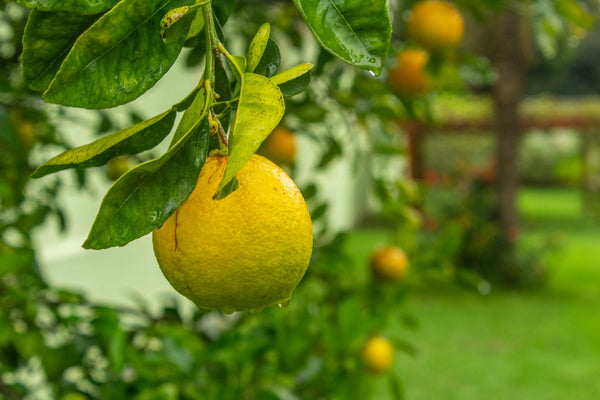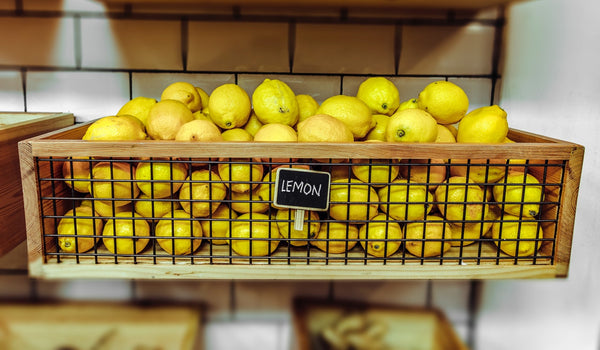Nothing embodies the warm, carefree vibe of spring and summer quite like citrus fruit. And lemon trees are arguably one of the best to choose for your own at-home orchard. Why? Well, for starters, they're super easy to grow and generally fruit quickly, even in less-than-stellar and cooler climates.
Plus, having a lemon tree is like having a little slice of the tropics right in your backyard. There's nothing like their fresh flavor and versatility.
Choosing Your Tree
Though it's a symbol of exotic, island-inspired growth, there are many places you can grow a lemon tree. Even if you live in an area where it gets cold outside, you can plant your lemon tree in a pot and bring it indoors during the winter. But if you're not sure what to choose, we've highlighted a few of our favorites below to get you started on your citrus journey!

1. Meyer Lemon
The famous favorite. The Meyer Lemon Tree is probably what comes to mind when you think of versatile indoor or outdoor growth and amazing, easy-to-grow flavor. It's especially known for offering both sweet and savory flavors from each squeeze, making it even better than store-bought.
In fact, Meyer Lemons aren't available in grocery stores because its thin skin is subject to easy bruising. However, this delicious skin also allows the citrus juices to develop fully, making it the perfect raw fruit for juices, desserts and flavoring.
While some lemon varieties can grow as tall as 20 feet, a Meyer Lemon tree will naturally reach between 10 and 15 feet tall.
2. Eureka Lemon
The top choice for growing juicy lemons on your patio is the Eureka Lemon Tree. Dwarf-sized for easy harvests, the Eureka Lemon offers effortless home-grown fruit and the benefit of drought tolerance.
It's no wonder the Eureka Lemon Tree is the most popular selection amongst homeowners who grow their own citrus fruit. You'll easily grow bushels of lemons that are great for lemonade or for adding a sweet flavor to your meals.
The Eureka is also adaptable to most soils and conditions, and you don't need to spray harsh chemicals because it isn't prone to pests or diseases.
3. Limequat Citrus
The Limequat Citrus Tree is technically not a lemon tree, but as a member of the citrus family, it's a must-have.
The Limequat is exactly how it sounds: a natural cross between a Key Lime Tree and a Kumquat Tree. This variety offers small, yellow-green, oblong fruit about the size of kumquats, which are perfect for snacking without peeling.
Limequats have the sweet flavor of limes and oranges with a tart aftertaste. Their unique flavor is perfect for cooking with, as well as adding to drinks, to give your favorite recipes some extra zest.
How to Plant Lemon Trees Indoors
Lemon Trees are a great low-maintenance plant and can grow perfectly even within your house!
As a citrus variety, lemon trees require full sun, which means about 6 to 8 hours of direct sunlight daily. For indoor growth, simply place them in front of a south-facing or sunny window.
Once you've scouted your chosen area and selected your favorite lemon tree, it's easy to plant. Select a container that's about one and a half or two times the width of your tree's shipped container. When selecting a container, make sure there are adequate drainage holes as any citrus will be unhappy with overly wet roots.

How to Plant Lemon Trees Outdoors
To plant outdoors, place your lemon tree in a south-facing area that gets plenty of sun and drains well. If you soil is clay or poor drainaing try mixing in some organic matter or compost to boost fertility and drainage of the area. Other than that, lemon trees just need a regular watering schedule and a plan for fertilizing.
The best time to plant your lemon tree is during the spring, to avoid any harsh winter or summer temperatures. This also depends on what growing zone you're located in so check and make sure that the ground isnt frozen and you are past the risk of frost.
Dig your hole just as deep and approximately twice as wide as the tree's root ball. After you've got everything ready, place your tree and loosen its roots just a bit. Then, backfill your hole with soil and 2 inches of compost and water well.
When the planting process is complete, you can also spread a 2 to 3 inch layer of mulch over the tree's root area to preserve moisture. Just ensure you keep the mulch away from the tree's bark.
Lemon Tree Care
So, how should you care for your lemon? Caring for your lemon tree can be broken down into these five steps: watering, fertilizing, pruning, pest & disease solutions and harvesting.
1. Watering
Generally, a lemon tree should be watered once weekly or bi-weekly, depending on rainfall in your area or your humidity indoors. A watering schedule is important to keeping your lemon trees healthy and happy. But if you're not sure when to water your lemon trees, just check the top 2 inches of soil. When this area is dry, it's time to water.
FGT Tip: Citrus leaves love humidity. Indoor lemon trees will do best if misted daily, especially when you're running your heat during cooler months. You can also use a humidifier or fill your pot's saucer with rocks and add water; place your plant on the rocks, ensuring the bottom of the pot is above the water line, for best results.
2. Fertilizing
We recommend fertilizing your lemon trees (especially Meyers) every four to six weeks, from February to August, to ensure a healthy cycle. Citrus trees benefit from fertilizers that are generally balanced with a slightly nitrogen-rich blend.
3. Pruning Your Lemon Tree
Prune as needed to maintain your lemon trees' shape. Clip any branches that are too long, and remove branches growing toward the trunk of the tree instead of away from it. This process maintains airflow between the branches and allows light to penetrate the center of the tree.
FGT Tip: Sterilize your pruning tools with rubbing alcohol. This ensures a clean cut to keep your lemon trees healthy.
4. Pest and Disease Solutions
Citrus canker, root rot and mites are the most common pests and diseases affecting lemon trees, but luckily, they're easy to treat, especially with organic, natural solutions. And if you keep your lemon trees indoors, you simply need to monitor and clean the leaves.
If you're treating, ensure that you always use an approved fungicide, or just remove any dead or diseased areas. Fully remove infected material from the tree. Don’t use any of this material for compost.
5. Harvesting
Now it's time for the best part: harvesting! Lemons are ready to pick when they're yellow or yellow-green on the outside. And most of our lemon trees are primed for harvest after only a couple of years, or sooner.
How Long Does it Take a Lemon Tree to Bear Fruit?
Lemons ripen anywhere between 4 and 12 months after flowering, with blooms appearing in spring to signal a later transition to fresh fruit in the summer. The exact time it takes for the fruit to develop will depend on the specific variety and growing conditions, but many of our lemon varieties will typically fruit within the first 1-2 years.
So, no matter the variety you choose, ease and home-grown flavor await - select your favorite from our delicious and juicy lemon trees today, and get growing!
And check out our Meyer Lemon Tips and Tricks for more helpful info!



